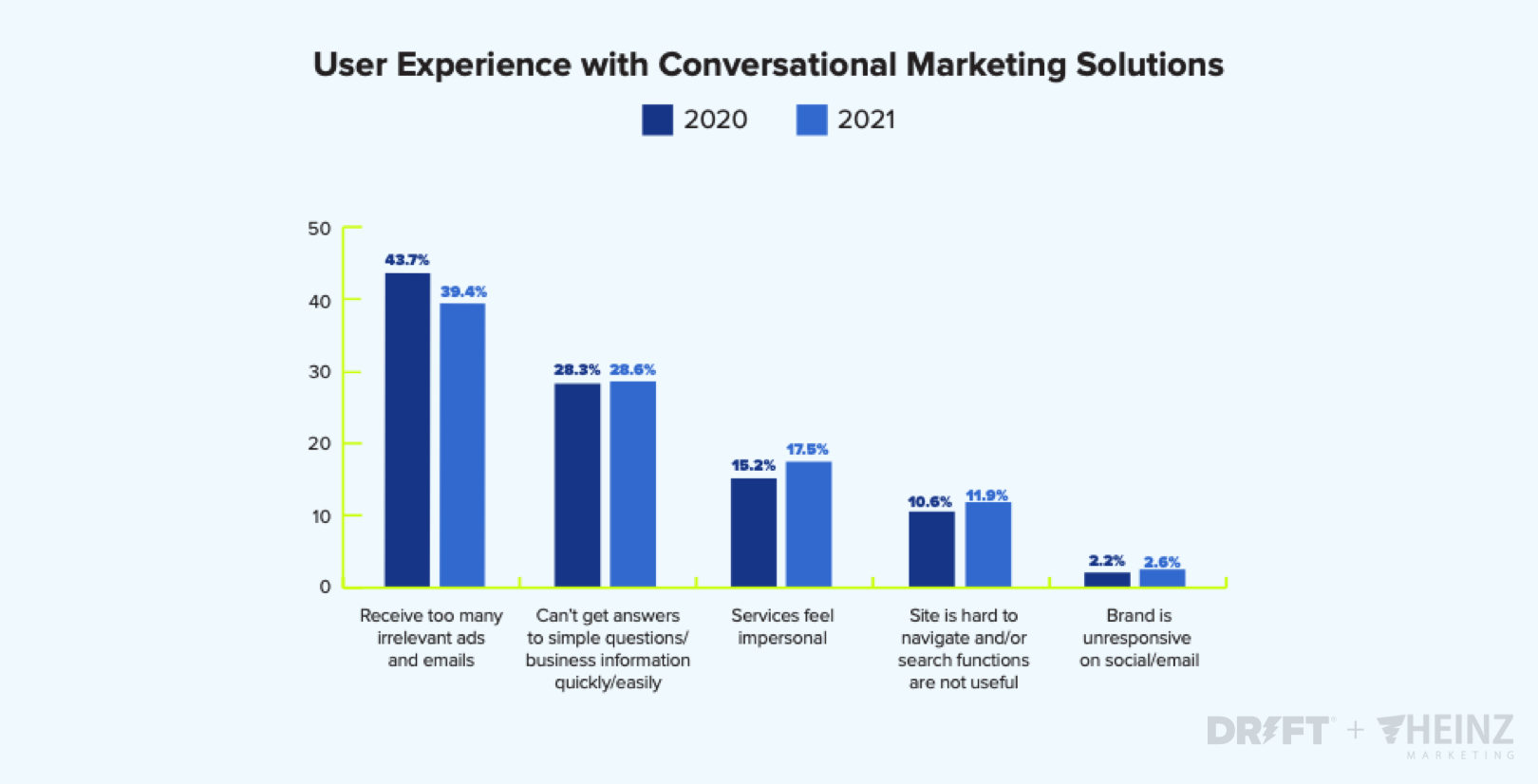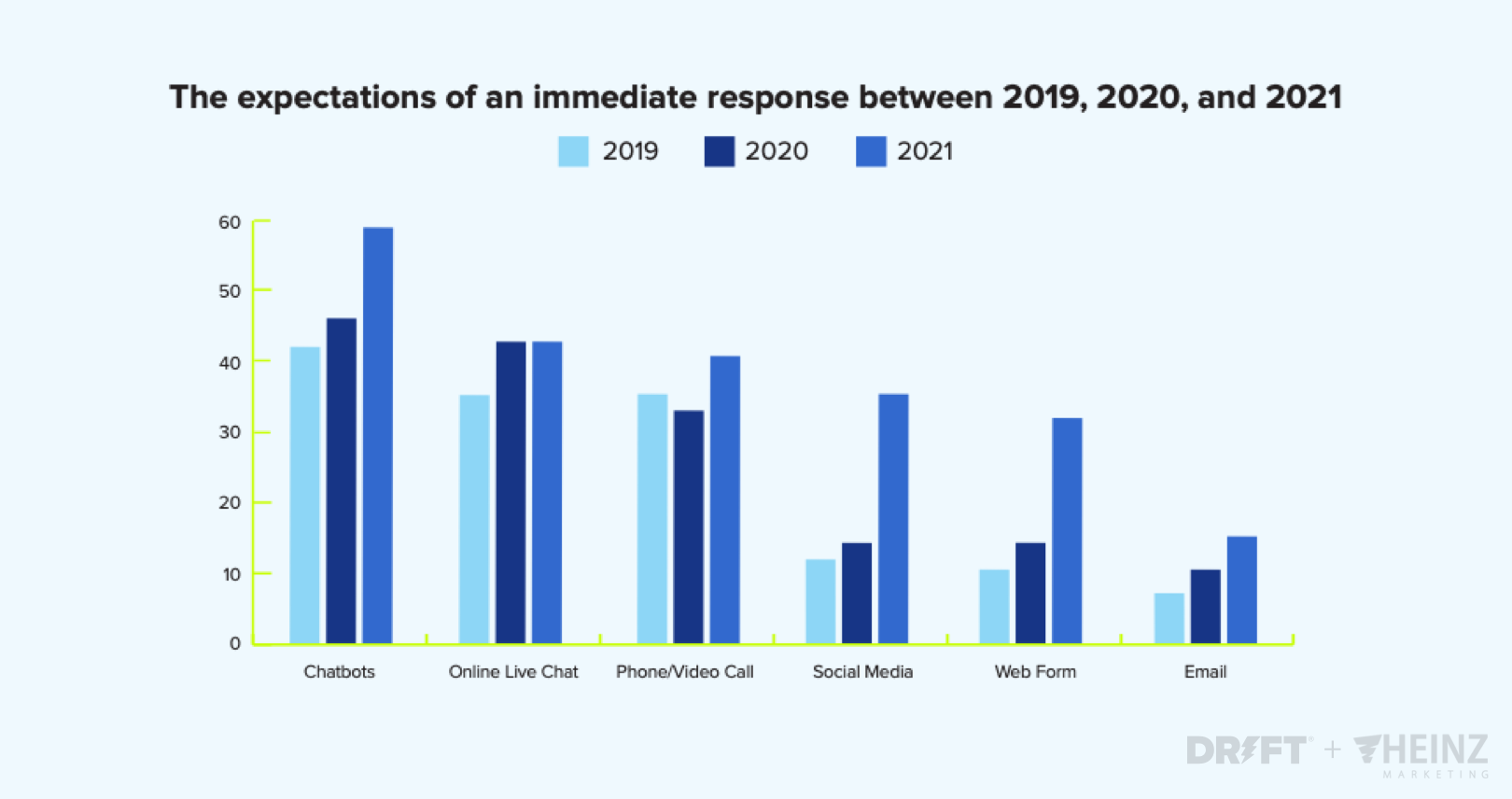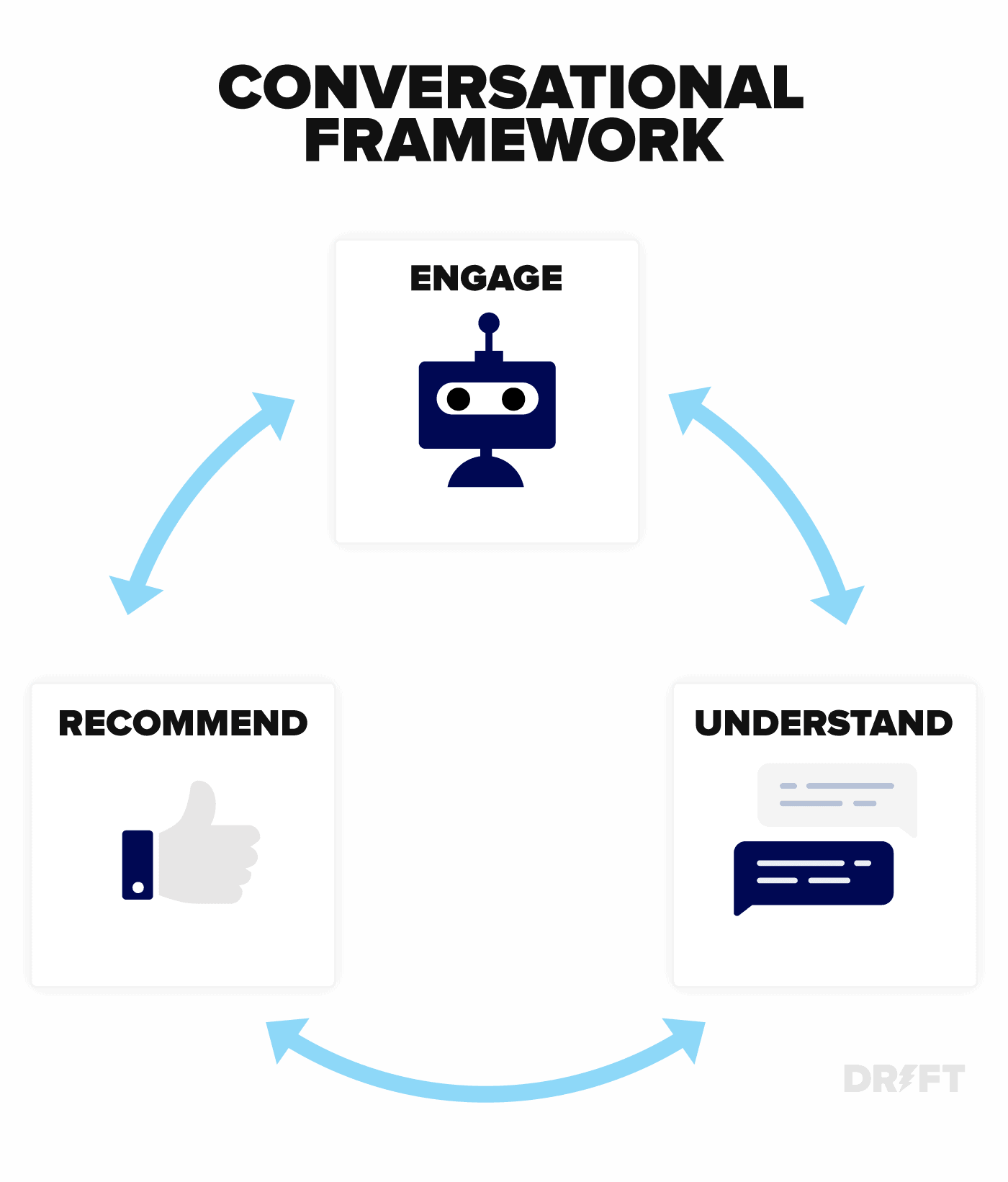Overall Frustration with B2B Digital Experiences is Rising
In our 2020 benchmark report, we focused on how the pandemic accelerated “digital transformation” in B2B companies. In 2021, we’ve found that B2B marketers are struggling to pivot their strategies around these new digital experiences and buyer expectations.
With more information accessible at all points of the customer journey, buyers are likely to disengage and seek resources elsewhere when experiencing frustration with a B2B website, product, or service.
Our research shows that consumer patience has worn thin when interacting with B2B businesses:
- Frustration with accessing basic business information has grown 20%
- Frustration with website navigation has grown 25%
- Frustration with old school forms continues to grow by 27%
 Unfortunately, Conversational Marketing was not immune to these B2B channel frustrations. Compared to 2020, positive user experience with Conversational Marketing solutions dropped by 10%. When considering all the outlying factors that affected B2B organizations during the pandemic, here are a few reasons for this slight decline in positive user experience:
Unfortunately, Conversational Marketing was not immune to these B2B channel frustrations. Compared to 2020, positive user experience with Conversational Marketing solutions dropped by 10%. When considering all the outlying factors that affected B2B organizations during the pandemic, here are a few reasons for this slight decline in positive user experience:
- Hasty onboarding and integration into current systems
- General uncertainty in the market
- Overall frustration with B2B products and services

We expect experiences with Conversational Marketing solutions will rebound as businesses have more time and proper training to align their solutions in their marketing strategies.
Quick & Authentic Experiences are a Top Priority for Businesses and Users
B2B buyers want better digital experiences from companies. And businesses want to deliver on those expectations. Today, buyers research products and services on their own time and expect lightning-fast responses to their inquiries.
That’s why one of the most appealing features of a Conversational Marketing solution is revealing buyer insights. Here are the top features Conversational Marketing users care about:
- 46.3% of respondents say learning more about buyers/customers is a top feature
- 36.2% of respondents say their solution provides a more human, authentic experience
- And 50.7% of respondents say they can provide quicker response times to visitor questions

If businesses want to provide a better buyer experience across their channels, they must engage with customers quickly and authentically.
Personalization is a Necessity
Personalization is no longer a “nice-to-have” feature of Conversational Marketing strategies – it’s a necessity. Our research shows buyers’ expectations for quick, personalized experiences have grown by 26%. This is the biggest shift in positive user experience factors next to instant response times.
According to Folloze Research, 77% of B2B sales and marketing professionals believe personalized marketing experiences improve customer relationships. B2B marketers are expected to deliver relevant content to their customers through preferred communication channels that match their buying journey stage.

COVID-19 Accelerated Conversational Marketing Adoption
Spurred by “digital transformation” during the pandemic, more businesses implemented Conversational Marketing solutions to provide a holistic customer experience and drive sales pipeline.
- More than half of respondents (58%) adopted a Conversational Marketing solution in response to COVID-19
- 99% of respondents said their Conversational Marketing solution was valuable to highly valuable — with 62% finding it is highly valuable
- Almost half of the respondents (45.2%) say their engagement rates increased during the pandemic
Why marketers chose to adopt Conversational Marketing depended greatly on their needs at the time. Here, we see a breakdown of the most common triggers.

According to Gartner, COVID-19 increased both the speed and scale of digital transformation, “escalating digital initiatives into digital imperatives.” This holds true in our findings. In 2020, some companies might have seen these new tools as quick fixes to a temporary problem. But now in 2021, most B2B marketers understand their Conversational Marketing solutions are essential to their marketing strategy.
The pandemic forced many B2B organizations to transform the way they capture interest, engage buyers, and convert demand to deliver meaningful results to their bottom line.
AI-Powered Conversational Marketing Solutions are Gaining Traction
Artificial intelligence (AI) is the new frontier of Conversational Marketing. According to a recent benchmark report of AI technology, marketers believe AI-enabled tools will be essential in B2B industries in the next five years.
82% of respondents who use an AI-enabled technology find their solution to be very valuable to their marketing mix. More specifically, respondents enjoy the strong sales and marketing engagement that AI-enabled solutions offer.
Of marketers who saw engagement with their Conversational Marketing solutions increase, 56% experienced increased sales productivity. Other AI-enabled benefits reported were:
- The ability to qualify customers in real-time (49%)
- The ease of engaging buyers 24/7 across the globe (41%)
- Efficient ticket support with online concierge (35%)
AI-enabled Conversational Marketing solutions have the power to automate common marketing tasks, accelerate revenue, and reduce costs. In 2021 alone, Gartner projects AI will create $2.9 trillion in business value. AI-enabled solutions give marketers a unique opportunity to have a competitive advantage by:
- Creating personalized consumer experiences
- Increasing marketing attribution
- Generating greater ROI on campaigns
- Getting more actionable insights from marketing data
- Streamlining repetitive business operations
- Shortening the sales cycle





 Unfortunately, Conversational Marketing was not immune to these B2B channel frustrations. Compared to 2020, positive user experience with Conversational Marketing solutions dropped by 10%. When considering all the outlying factors that affected B2B organizations during the pandemic, here are a few reasons for this slight decline in positive user experience:
Unfortunately, Conversational Marketing was not immune to these B2B channel frustrations. Compared to 2020, positive user experience with Conversational Marketing solutions dropped by 10%. When considering all the outlying factors that affected B2B organizations during the pandemic, here are a few reasons for this slight decline in positive user experience:


